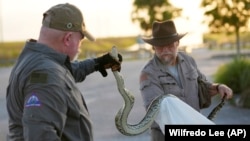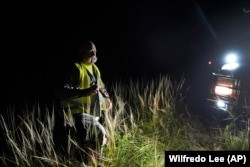It is after midnight when the windshield fogs up on Thomas Aycock’s pickup truck. He smiles as he slowly drives through the sawgrass and down dirt roads deep in the Florida Everglades.
His foggy windshield confirms what he knows. When the dew point drops in the middle of the night, it is perfect time for pythons.
“I catch more pythons when that happens,” Aycock said. The retired U.S. Army veteran always takes part in the Florida Python Challenge. The wildlife commission runs the 10-day event. The aim is to get people interested in finding and catching the snakes.
There is a reason for the timing of the event. Pythons usually hatch from their eggs each August before finding their way into the swamp.
Aycock works for the Florida Fish and Wildlife Conservation Commission. He has hunted Burmese pythons in the Everglades for 11 years. Aycok loves snakes. And he loves preserving the Everglades. He understands the “greater ecological issue with these pythons.”
The invasive Burmese pythons are doing very well in Florida’s preserved wetlands. Pythons have no natural predators. And they are threatening Florida’s native snakes and mammals. The United States Geological Survey (USGS) estimates tens of thousands live in South Florida.
The snakes are destroying local wildlife. In one 2012 study, the USGS found that populations of raccoons had declined by 99.3 percent, opossums by 98.9 percent and bobcats by 87.5 percent since the early 2000s. Controlling this hungry snake, scientists say, is a critical goal.
More than 600 hunters took part in this year’s challenge. Their goal is to beat last year’s top total of 209 pythons killed. The hunter who kills the most wins $10,000.
The competition is designed to create understanding about Florida’s python problem. It has succeeded in doing that. The event has drawn famous people and has led to some reality television shows.
But the need for python control remains urgent.
Since 2017, Florida has been paying about 100 contractors to catch the snakes year-round. That project is shared by the wildlife agency and the South Florida Water Management District. Through 2023, more than 18,000 pythons have been removed from the wild. Contractors like Aycock have removed about 11,000.
The pay is average. Hunting along backroads pays $13 an hour. Walking through the swamp pays $18 an hour. Contractors also get paid per snake: $50 for the first 1.2 meters in length, plus more for longer snakes.
“You’re not going to make a living doing this full-time. There’s no way you could do it,” Aycock said.
Florida does not permit hunters to use firearms to kill pythons. Catching them is a hands-on exercise.
Aycock goes into the wetlands to check on known hatching spots and grabs at them when he can. But mostly he drives down empty roads at night, shining a strong light into the swamps.
He says these bug-filled drives help his mental health. Sometimes he brings along fellow members of the Swamp Apes, a mental health non-profit organization for veterans. The group catches invasive snakes in the wild, clears overgrown areas, and works toward environmental preservation.
The group’s founder, Tom Rahill, is also a snake hunting contractor. He knows the swamp so well that he can smell a python’s “musk” odor. He says he can feel when a snake is near.
There is an art to catching a snake, the hunters say. The methods change from hunter to hunter. Some use a snake hook and then jump on them before putting them into bags. Rahill likes using his hands -- if the snake is calm enough.
“Instead of jumping on the snake, you just kind of gently get up to it and then just pick it up,” he said.
But the snakes are not always calm. Sometimes a hunter needs a helper to keep the snake uncoiled until it calms down and can be contained to prevent escape.
Once the snakes are caught, the hunters have 24 hours to take them to the wildlife agency. It is illegal for any person other than a licensed contractor to transport a live, invasive snake.
Aycock takes them home first to be “humanely killed.”
“That’s the part of the job that I really just ... hate,” he said. “I hate having to kill snakes.”
I’m Anna Matteo.
Stephany Matat reported this story for The Associated Press. Anna Matteo adapted it for VOA Learning English.
____________________________________________
Words in This Story
fog (up) – v. when small particles of water floating in the atmosphere are near the ground and on surfaces
hatch – v. to emerge from an egg, chrysalis, or pupa
swamp – n. wet spongy land often partly covered with water
invasive – adj. tending to spread especially in a quick or aggressive manner: such as
preserved – v. to keep safe from injury, harm, or destruction
predator – n. an animal that obtains food mostly by killing and eating other animals
native – adj. living or growing naturally in a particular region
contractor – n. a person who contracts to perform work or provide supplies at a certain price or within a certain time
coiled – v. to wind into or lie in loops, rings, or a spiral : uncoiled – v. to unwind from a coil and become straight
licensed – adj. having permission granted by competent authority to engage in a business or occupation or in an activity otherwise unlawful











Forum